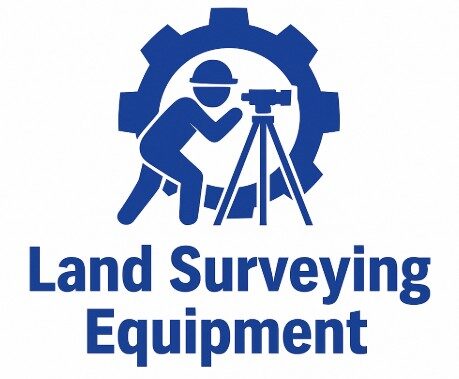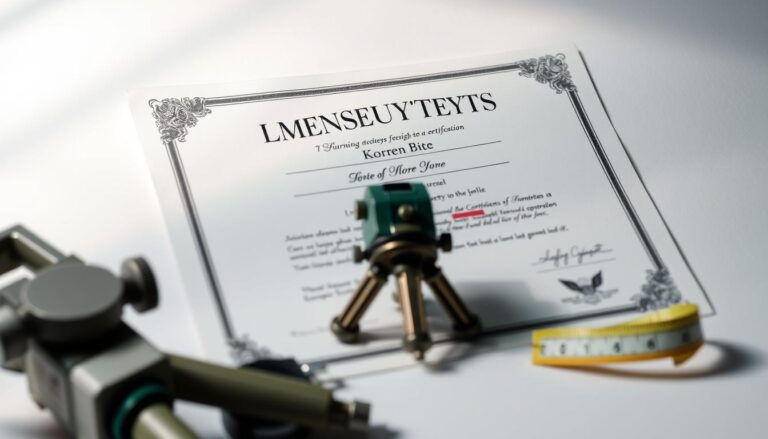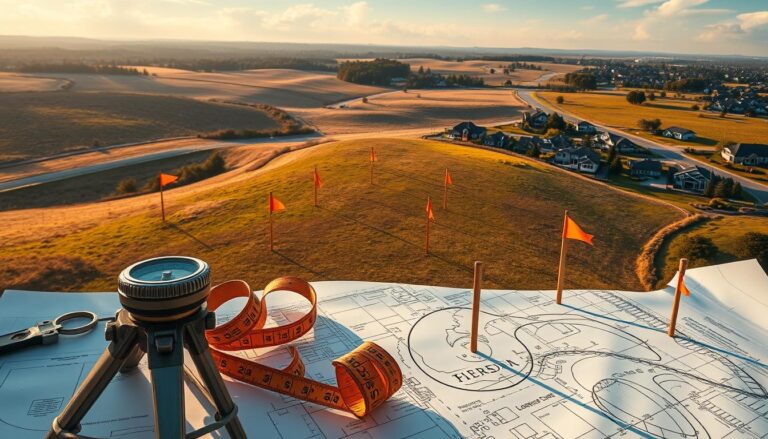Courthouse Research for Land Surveying Explained
Courthouse research plays a vital role in land surveying, providing essential data for boundary determinations and property analyses.
Understanding the significance of courthouse research is crucial for land surveyors, as it involves examining public records to verify property ownership and boundaries. Key components of this research include examining deeds, which detail the transfer of property from a grantor to a grantee, and reviewing map books that contain historical plats and surveys.
According to Knud E. Hermansen in “Researching the Records – The Basics,” thorough research is fundamental to accurate land surveying. By delving into these records, surveyors can reconstruct property histories and resolve boundary disputes.
Key Takeaways
- Understanding the importance of courthouse research in land surveying.
- Identifying key components involved, such as deeds and map books.
- Recognizing the role of grantor and grantee in property transactions.
- The significance of historical records in boundary determinations.
- The impact of thorough research on the accuracy of land surveys.
The Fundamentals of Courthouse Research in Land Surveying
Understanding the fundamentals of courthouse research is essential for land surveyors to accurately determine property lines and resolve potential disputes. Courthouse research involves investigating public records to uncover the history of property ownership and boundaries.
Definition and Purpose
Courthouse research is defined as the process of examining public records maintained in courthouses to gather information about property transactions, ownership, and boundaries. The primary purpose of this research is to provide land surveyors with the necessary data to conduct accurate surveys and resolve boundary disputes.
Legal Basis for Courthouse Research
The legal basis for courthouse research lies in the public records laws that require the maintenance and accessibility of property records. These laws ensure that the information gathered during courthouse research is reliable and admissible in legal proceedings.
Historical Context of Land Records
Land records have evolved significantly over time, influenced by changes in laws, technology, and societal needs. Historically, land records were maintained in handwritten ledgers and maps, which were prone to errors and deterioration.
Evolution of Record-Keeping Systems
The evolution of record-keeping systems has transformed the way land records are maintained and accessed. Modern courthouses now utilize digital databases and electronic filing systems, making it easier for land surveyors to conduct research. Digital records have improved the accuracy and efficiency of courthouse research.

What is Courthouse Research for Land Surveying and How is it Done
Courthouse research is an indispensable step in land surveying that helps in establishing the chain of title and resolving potential boundary disputes. It involves a systematic investigation into public records to gather historical data about land ownership and boundaries.
Core Components of Courthouse Research
The core components of courthouse research include accessing public records and investigating the chain of title. Public Records Access is crucial as it provides land surveyors with the necessary documents to understand property transactions and legal descriptions.
Public Records Access
Land surveyors must access various public records, including deed records and map books, to gather comprehensive information about a property’s history. Deed research, in particular, can be invaluable for those involved in buying and selling land, as it helps to verify ownership and identify potential issues.
Chain of Title Investigation
Investigating the chain of title is another critical aspect of courthouse research. It involves tracing the historical ownership of a property to ensure that the current owner has a valid claim to the land.
General Methodology and Workflow
The general methodology for courthouse research involves several key steps, starting with Preliminary Research Planning. This stage is essential for identifying the necessary records and developing a research strategy.
Preliminary Research Planning
Before visiting the courthouse, land surveyors should plan their research by identifying the types of records they need to access and the potential challenges they may face.
On-Site Research Execution
Once at the courthouse, surveyors must efficiently execute their research plan, accessing the required records and taking detailed notes. 
By following a structured approach to courthouse research, land surveyors can ensure that they gather accurate and comprehensive information, ultimately leading to more precise land surveys.
The Critical Role of Courthouse Records in Land Surveying
Understanding the critical role of courthouse records is fundamental for land surveyors to accurately determine property lines and resolve potential disputes. Whether you’re a first-time property owner or looking to expand your home, knowing the exact location of your land’s property lines is important.
Legal Boundaries Establishment
Courthouse records are essential for establishing legal boundaries. They contain historical data and previous surveys that help in accurately defining property lines.
Resolving Boundary Discrepancies
These records aid in resolving boundary discrepancies by providing evidence of past agreements and surveys, thus helping to clarify any confusion regarding property limits.
Dispute Resolution and Prevention
Courthouse records also play a crucial role in dispute resolution and prevention. By documenting property transactions and boundaries, they provide a clear reference point for resolving conflicts.
Evidence Collection for Legal Proceedings
In cases of disputes, these records serve as vital evidence in legal proceedings, supporting the claims of property owners and helping to reach a resolution.
Understanding Grantor Records in Land Surveying
The significance of grantor records in land surveying cannot be overstated, as they offer vital information on property transactions. Grantor records are essential documents that detail the history of property ownership, providing land surveyors with the necessary information to establish accurate property boundaries.
Definition and Importance of Grantors
A grantor is an individual or entity that transfers property ownership to another party, known as the grantee. Grantors play a crucial role in land surveying as their records help surveyors trace the history of property ownership.
Legal Implications of Grantor Status
The legal implications of being a grantor are significant, as it involves the transfer of property rights. Understanding the grantor’s status is vital in determining the validity of property transactions.
How to Access and Interpret Grantor Indices
Grantor indices are typically maintained by county recorder’s offices or courthouses. To access these records, land surveyors can search online databases or visit the courthouse in person. Interpreting grantor indices requires a thorough understanding of the indexing system used, which can be either chronological or alphabetical.
Chronological vs. Alphabetical Systems
Chronological systems organize records by date, while alphabetical systems organize them by the grantor’s name. Understanding the differences between these systems is crucial for efficient research.
Common Challenges with Grantor Records
One of the common challenges faced by land surveyors is dealing with name variations in grantor records. Strategies for resolving these variations include using multiple search terms and cross-referencing different records.
Strategies for Resolving Name Variations
- Use of wildcards in search queries
- Cross-referencing with other historical records
- Consulting with local historians or genealogists
By understanding grantor records and how to access and interpret them, land surveyors can ensure accurate property boundary determinations and resolve potential disputes.
Navigating Grantee Records for Accurate Surveys
Grantee records play a crucial role in land surveying, providing essential information for accurate boundary determinations. These records are vital for understanding the chain of ownership and the legal descriptions of properties.
Definition and Significance of Grantees
A grantee is the individual or entity that receives property or an interest in property through a deed or other legal instrument. Understanding the role of grantees is essential for land surveyors, as it helps in tracing the history of property transactions.
Rights and Responsibilities of Grantees
Grantees have the right to possess and use the property as described in the deed. They are also responsible for ensuring that the property is used in compliance with local regulations and that any issues related to the property’s boundaries are addressed.
Accessing and Analyzing Grantee Information
Grantee information can be accessed through courthouse records, typically found in grantor-grantee indices. Analyzing this information requires careful examination of the deeds and other documents to understand the property’s history.
Cross-Referencing Techniques
Cross-referencing involves comparing grantee records with other relevant documents, such as grantor records and map books, to ensure accuracy and completeness. This technique helps in identifying any discrepancies or potential issues.
Potential Pitfalls in Grantee Research
One of the common pitfalls in grantee research is dealing with incomplete or inaccurate records. This can lead to confusion and errors in determining property boundaries.
Solutions for Incomplete Records
To overcome the issue of incomplete records, surveyors can use various techniques, such as consulting other historical documents or conducting field investigations to gather additional information.
Map Books: Essential Resources for Land Surveyors
For land surveyors, map books serve as a foundational tool, offering insights into property boundaries and historical land transactions. These resources are critical for understanding the complex history of land ownership and boundaries.
Types of Map Books Available in Courthouses
Courthouses typically maintain various types of map books, each serving a distinct purpose in land surveying. The availability of these resources can significantly impact the accuracy of land surveys.
Plat Books vs. Survey Maps
Plat books and survey maps are two primary types of map books. Plat books provide a detailed representation of land subdivisions, including lot numbers, dimensions, and adjacent properties. In contrast, survey maps offer precise measurements and boundary information, often including topographical features.
Information Contained in Map Books
Map books contain a wealth of information, including property boundaries, historical land transactions, and survey data. This information is vital for determining property lines, identifying potential disputes, and resolving boundary issues.
Reading and Interpreting Map Notations
Understanding the notations used in map books is crucial. Surveyors must be able to interpret symbols, scales, and other map features to extract relevant data. This skill requires a combination of knowledge and experience.
Techniques for Efficient Map Book Research
Efficient research involves a systematic approach to reviewing map books. Surveyors should focus on relevant time periods and geographical areas, using indexes and catalogs to locate specific maps.
Digital Map Resources and Integration
The integration of digital map resources has enhanced the efficiency of map book research. Digital tools allow for easier access and analysis of map data, enabling surveyors to compare historical and current maps more effectively.
Deed Research: The Cornerstone of Property Boundaries
In the realm of land surveying, deed research plays a pivotal role in establishing property boundaries. Deed research is fundamental to understanding the history and legal description of a property, which is crucial for accurate land surveying.
Components of a Deed Document
A deed document contains essential information about a property transfer, including the grantor and grantee names, legal description of the property, and any conditions or restrictions on the property.
Legal Descriptions and Their Formats
Legal descriptions are a critical component of a deed document, providing a detailed written description of the property boundaries. These descriptions can be in various formats, such as metes and bounds, lot and block, or government survey system.
Methods for Tracing Deed Histories
Tracing deed histories involves examining past deed transactions to understand the chain of ownership and identify any potential issues with the property title.
Backward and Forward Title Searches
Backward title searches involve tracing the ownership history from the current owner back to the original grantor, while forward title searches start from the original grantor and follow the chain of ownership forward to the current owner.
Key steps in tracing deed histories include:
- Examining grantor and grantee records
- Reviewing deed documents for accuracy and completeness
- Analyzing legal descriptions for consistency
Resolving Conflicting Deed Information
Conflicting deed information can arise due to errors in recording, ambiguous legal descriptions, or overlapping property claims.
Hierarchy of Evidence in Deed Conflicts
When resolving deed conflicts, surveyors rely on a hierarchy of evidence, with the most reliable sources being original survey documents, followed by recorded deeds, and then other supporting documents.
If you’re one of those interested in buying and selling your land, deed research can help you understand the property boundaries and potential issues with the title.
Step-by-Step Process for Conducting Courthouse Research
Conducting courthouse research is a crucial step in land surveying that requires meticulous preparation and a systematic approach. This process involves several key steps that help surveyors gather accurate and reliable information.
Preparation Before Visiting the Courthouse
Before visiting the courthouse, it’s essential to prepare by gathering all necessary documentation and information. This includes understanding the property’s history, identifying relevant grantor and grantee records, and familiarizing oneself with local map books and deed records.
Required Documentation and Information
Surveyors should come prepared with the necessary documents, such as property deeds, and information about the property’s location and history. This preparation helps streamline the research process and ensures that all relevant records are identified and reviewed.
On-Site Research Procedures
Upon arriving at the courthouse, surveyors should follow a systematic approach to researching the records. This involves interacting with courthouse staff to understand the available resources and how to access them efficiently.
Interaction with Courthouse Staff
Courthouse staff can provide valuable insights into the organization and accessibility of records. Surveyors should be prepared to ask relevant questions and seek guidance on navigating the records system, including how to access grantor and grantee indices, map books, and deed records.
Documentation and Organization of Findings
Once the research is conducted, it’s crucial to document and organize the findings properly. This involves creating a detailed research log and evidence trail to ensure that all information is accurately recorded and easily accessible.
Creating a Research Log and Evidence Trail
A research log helps track the progress of the research, noting the sources consulted and the information found. An evidence trail provides a clear record of the documents and records examined, supporting the surveyor’s conclusions and facilitating future reference.
By following these steps and maintaining a thorough and organized approach, surveyors can ensure that their courthouse research is comprehensive and reliable, ultimately supporting accurate land surveying outcomes.
Digital vs. Physical Courthouse Records: Pros and Cons
Courthouse records, whether digital or physical, play a crucial role in land surveying, each with its own set of advantages and disadvantages. The choice between utilizing digital or physical records depends on various factors, including the nature of the research, the resources available, and the specific requirements of the survey.
Advantages of Digital Records Systems
Digital records systems offer several benefits, including enhanced accessibility and efficiency. One significant advantage is the ability to access records remotely.
Remote Access Capabilities
Remote access to digital records allows land surveyors to conduct preliminary research from anywhere, saving time and reducing the need for physical visits to the courthouse. Many local governments now keep property records online, facilitating this process.
Benefits of Physical Document Research
Despite the advantages of digital records, physical document research remains invaluable. It provides an opportunity to examine original documents and records that may not be digitized.
Accessing Non-Digitized Historical Records
Physical research allows surveyors to access historical records that are not available in digital format. These records can be crucial for understanding the historical context of land ownership and boundaries.
Hybrid Approaches for Comprehensive Results
A combination of digital and physical research methods often yields the most comprehensive results. By leveraging the strengths of both approaches, land surveyors can ensure a more thorough understanding of the records.
Integrating Digital and Physical Research Methods
Surveyors can start with digital records to quickly identify relevant information and then visit the courthouse to review physical documents. This hybrid approach maximizes efficiency while ensuring accuracy.
Common Challenges in Courthouse Research and How to Overcome Them
The process of courthouse research can be fraught with challenges that land surveyors must learn to overcome. Despite the importance of accurate records, courthouse research is often complicated by issues such as missing or damaged records, inconsistent naming conventions, and complex legal descriptions.
Missing or Damaged Records
One of the most significant challenges in courthouse research is dealing with missing or damaged records. This can occur due to various reasons such as natural disasters, poor storage conditions, or simple misfiling.
Alternative Sources for Lost Information
When records are missing or damaged, land surveyors can seek alternative sources to reconstruct the necessary information. Some of these sources include:
- Other government agencies that may have duplicate records
- Private archives or historical societies
- Newspaper archives or other public records
Utilizing these alternative sources can help mitigate the issue of missing records and ensure the continuity of the research process.
Inconsistent Naming Conventions
Inconsistent naming conventions pose another challenge in courthouse research. Variations in spelling, abbreviations, or name changes over time can make it difficult to trace property histories.
Name Variation Search Techniques
To overcome this, land surveyors can employ various search techniques, such as:
- Using wildcard characters in search queries
- Conducting phonetic searches
- Examining historical documents for name variations
By adopting these techniques, researchers can increase the likelihood of finding relevant records despite naming inconsistencies.
Navigating Complex Legal Descriptions
Complex legal descriptions can also hinder courthouse research. Old deeds and land grants often contain archaic terminology or ambiguous descriptions that require careful interpretation.
Tools for Deciphering Archaic Terminology
To navigate these complexities, land surveyors can use specialized tools and resources, such as:
- Historical dictionaries and legal lexicons
- Online resources and forums dedicated to land surveying and historical research
- Expert consultation with historians or legal professionals
By understanding these common challenges and employing strategies to overcome them, land surveyors can enhance the efficiency and accuracy of their courthouse research.
Tools and Technologies for Efficient Courthouse Research
Courthouse research is a cornerstone of land surveying, and utilizing the appropriate tools and technologies can make this task more efficient. Professional surveyors often charge for the time spent researching properties, making it essential to optimize this process.
Essential Software for Land Surveyors
Land surveyors rely on specialized software to manage and analyze courthouse data effectively. One crucial aspect is the integration of Geographic Information Systems (GIS) with courthouse records.
GIS Integration with Courthouse Data
GIS technology allows surveyors to visualize and analyze spatial data in conjunction with courthouse records, enhancing the accuracy of land surveys. By integrating GIS with courthouse data, surveyors can identify patterns and relationships that might not be apparent through manual research alone.
Physical Tools for On-Site Research
While digital tools are increasingly important, physical tools remain essential for on-site courthouse research. These include documentation and reproduction equipment.
Documentation and Reproduction Equipment
Surveyors use various physical tools such as scanners, cameras, and photocopiers to document and reproduce courthouse records. High-quality documentation is critical for maintaining accurate records and preventing data loss.
Modern Technological Advancements
The field of courthouse research is continually evolving with technological advancements. One significant development is the use of mobile applications for courthouse research.
Mobile Applications for Courthouse Research
Mobile apps designed for courthouse research enable surveyors to access records, take notes, and capture documents on-site, improving efficiency and reducing the likelihood of errors. These apps can also facilitate the organization of research findings.
By leveraging these tools and technologies, land surveyors can significantly enhance the efficiency and accuracy of their courthouse research, ultimately leading to better outcomes in land surveying projects.
Conclusion: Mastering Courthouse Research for Successful Land Surveying
Mastering courthouse research is crucial for land surveyors to ensure accurate and reliable land surveys. Understanding courthouse research in land surveying is vital for establishing legal boundaries, resolving disputes, and preventing potential issues.
The importance of courthouse research in land surveying cannot be overstated. By thoroughly examining grantor and grantee records, map books, and deed documents, land surveyors can gain a comprehensive understanding of property histories and boundaries.
Effective courthouse research requires a combination of traditional techniques and modern technologies. By leveraging these tools and techniques, land surveyors can streamline their research process, reduce errors, and improve overall efficiency.
Ultimately, mastering courthouse research is essential for successful land surveying. By doing so, land surveyors can provide accurate and reliable surveys, minimize disputes, and ensure compliance with regulatory requirements.






